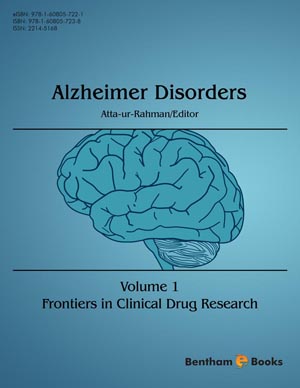Abstract
Late onset Alzheimer's disease (AD) is the most common cause of dementia in the western world. Available extensive evidence supports the concept that AD is fundamentally a multifactorial syndrome that results in progressive psychiatric and cognitive impairment. Several clinico-pathological and epidemiological data emphasize overlaps of pathological cascades, e.g. aging, cerebrovascular pathology and obesity, and their synergistic effects in promoting cognitive and memory decline/AD. In comparison with normal controls, patients with amnestic mild cognitive impairment (MCI) who converted to AD showed cerebral hypoperfusion particularly in the parietal, parahippocampal, inferior temporal and fusiform gyri, whereas those who did not convert yet showed hypoperfusion in the retrosplenial cortex. This suggests that promotion and progression of cognitive decline may precede neuronal damage. The current chapter addresses this important issue and delineates the factors responsible for hypoxia, hypoxemia, cerebral hypoperfusion and compromised blood supply, brain hypometabolism in aging and AD. In the normally aged brain -perfusion, oxygen consumption and glucose metabolism remain quite unchanged from the 3rd to the 7th decade. Thereafter, they decline and lead to relatively lower hypoperfusion, and glucose hypometabolism in aging. This disturbance arises due to snoring and obstructive sleep apnea (OSA) that cause chronic intermittent hypoxia (which is highly prevalent in the obese). OSA could be as much as 50 per hour (or more) – i.e. an apnea-hypopnea index of 50. Hence a scenario of chronic hypoxia/hypoxemia may promote cerebral ischemia, changes in oxygen consumption, and glucose hypometabolism -documented in the temporo-parietal cortex of OSA sufferers as well as AD patients. A convergence of “Age” – a proinflammatory state, and several other stigmata due to hypoxia/hypoxemia may upregulate neuroinflammation and enhance oxidative stress. The confluence of the above pathogenic cascades may depress neuronal function by rendering synapses, neurotransmission, and brain metabolism dysfunctional, and thus provoke and enhance cognition impairment. This progressive/evolving neurodegenerative process is also manifested by amyloid angiopathy, and the formation/deposition of amyloid plaques and neurofibrillary tangles -the quintessential hallmarks of Alzheimer’s dementia. Animal models of intermittent hypoxia have consistently documented upregulation of amyloid beta and neuronal apoptosis -being widespread in key foci of cortex and brainstem.
Keywords: Aging, Alzheimer’s disease, Obstructive sleep apnea, hypoxia, hypoxemia, obesity, systemic inflammation, oxidative stress, cardiovascular disease, hypertension, hypoperfusion, hippocampus, hypometabolism, amyloid, neurofibrillary tangles, neurocognitive dysfunction, memory loss, diabetes mellitus, synapse, sensory loss.






















